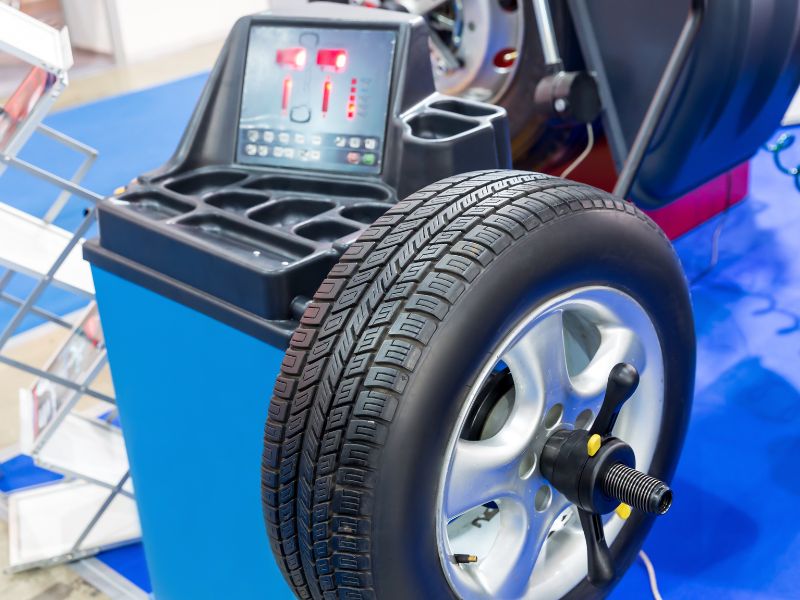In some cases, a car will start shaking at specific conditions, and in this article, we will focus on why the car shakes at high speed.
Many reasons can cause the car to vibrate at high speed, like unbalanced or bent wheels, loose wheel lug nuts, loose wheel bearings, worn out outer tie rods, worn out wheel ball joints, and on solid axle cars, death wobble.
With the reasons listed, let’s delve deeper into why they would result in the car shaking at high speed.

6 Causes That The Car Shakes At High Speed
1. Unbalanced Or Bent Wheels
The rims and the tires, even though they are manufactured at a very high standard, still have some imbalances to them.
So the entire wheel combo needs to be balanced on a tire balancing machine and weights added to the inner and outer edge of the rim.
If this is not done or, for some reason, the weights fall off or your wheel is bent, the wheel will oscillate the faster you drive, resulting in the vehicle shaking at high speed.
This is the most common reason a car shakes at high speed.
2. Loose Wheel Lug Nuts
Wheel nuts or lug nuts are following; their job is to hold the wheel to the vehicle’s hub.
If the lug nuts are not adequately fastened, the wheel can wobble on the hub of the vehicle resulting in the car shaking at a higher speed and even under braking.
The wheel lug nut holes won’t last forever in this situation and will later break away from the hub of the vehicle, which is very dangerous and can result in an accident.
3. Loose Wheel Bearings
Moving more inboard, we find the wheel hub connected to the steering knuckle of the car with a wheel bearing.
The only thing holding the wheel bearing is one large nut with a locking plate or split pin to prevent the nut from backing out.
When there was work done on the vehicle, there can be a chance that the locking plate or split pin was not installed unconsciously, or over time, the wheel bearing can fail and develop a play.
This play in the wheel bearing has the same results as the wheel lug nuts that are loose, and the entire wheel assembly will start wobbling and worsen the faster you go.
4. Worn Out Outer Tie Rods
The outer tie rods connect the steering knuckle of the vehicle to the steering of the car; on most modern vehicles, it will connect to the inner tie rod and then to the steering rack.
While on older solid axle vehicles and trucks, it will connect to the steering arms that are connected to the steering box.
The outer tie rod has a spherical bearing; over time, it will wear out and develop a play, and if ignored for long enough, it can be so bad that the tiniest movement of the wheel can result in the wheel oscillating back and forth.
The vague steering inputs will hopefully make you take the vehicle to get fixed before it becomes so bad.
5. Worn Out Ball Joints
The ball joint connects the steering knuckle to the vehicle’s suspension with spherical ball joints.
If these ball joints start developing play over the years of use, it can alter the geometry of the steering knuckle.
It can make the steering knuckle and wheel assembly move inboard and outboard quickly, making the vehicle shake worse as the speed increases.
6. Death Wobble
This is a well-known issue in the Jeep community, especially with the Wranglers, but it can happen to any solid axles vehicle with worn-out or inadequate steering dampers.
Death wobble is when the front wheels go over or into an obstacle on the road, and since the steering dampener is worn out or inadequate, the impact cant is absorbed, and the movement will start moving the front wheels left to right, the higher the speed, the faster it does it.
Here is a video that gives an excellent visual explanation of what death wobble is, and as you will see, it is the worst shake you will experience in a vehicle at speed.
Final Thoughts On Car Shakes At High Speed
While car shaking can occur at low speeds, acceleration, and even braking, the worst is at high speeds.
The sense of losing control of the vehicle is not pleasant, and hopefully, the article will help you diagnose the problem of why your car shakes at high speed.

FAQs
Why Is My Car Shaking At 70 MPH?
The biggest culprit in most cases is imbalanced wheels; as the speed increases, so does the shaking.
Other factors include loose wheel lug nuts, loose wheel bearings, worn-out outer tie rods, worn-out ball joints, and death wobble on solid axle cars.
Is It Bad To Drive When The Car Is Shaking?
Yes, continuous driving while the car shakes can put unnecessary strain on many parts of the car, like suspension components, brakes, steering, and interior parts.
While it won’t damage anything in a short period, the constant vibrations can damage the rubber mounts of the suspension, engine, transmission, and subframes.
It can also cause interior squeaks and rattles to appear if it starts loosening clips or screws.
Can Low Brake Fluid Cause Shaking?
No, it does not cause the car to shake, but it can cause the brake pedal to feel spongy.
If the brake disc is warped and you apply the brakes, the car can start shaking since the disc is pushing the brake caliper in and out of the brake sleeve resulting in the brake system pulsating.
